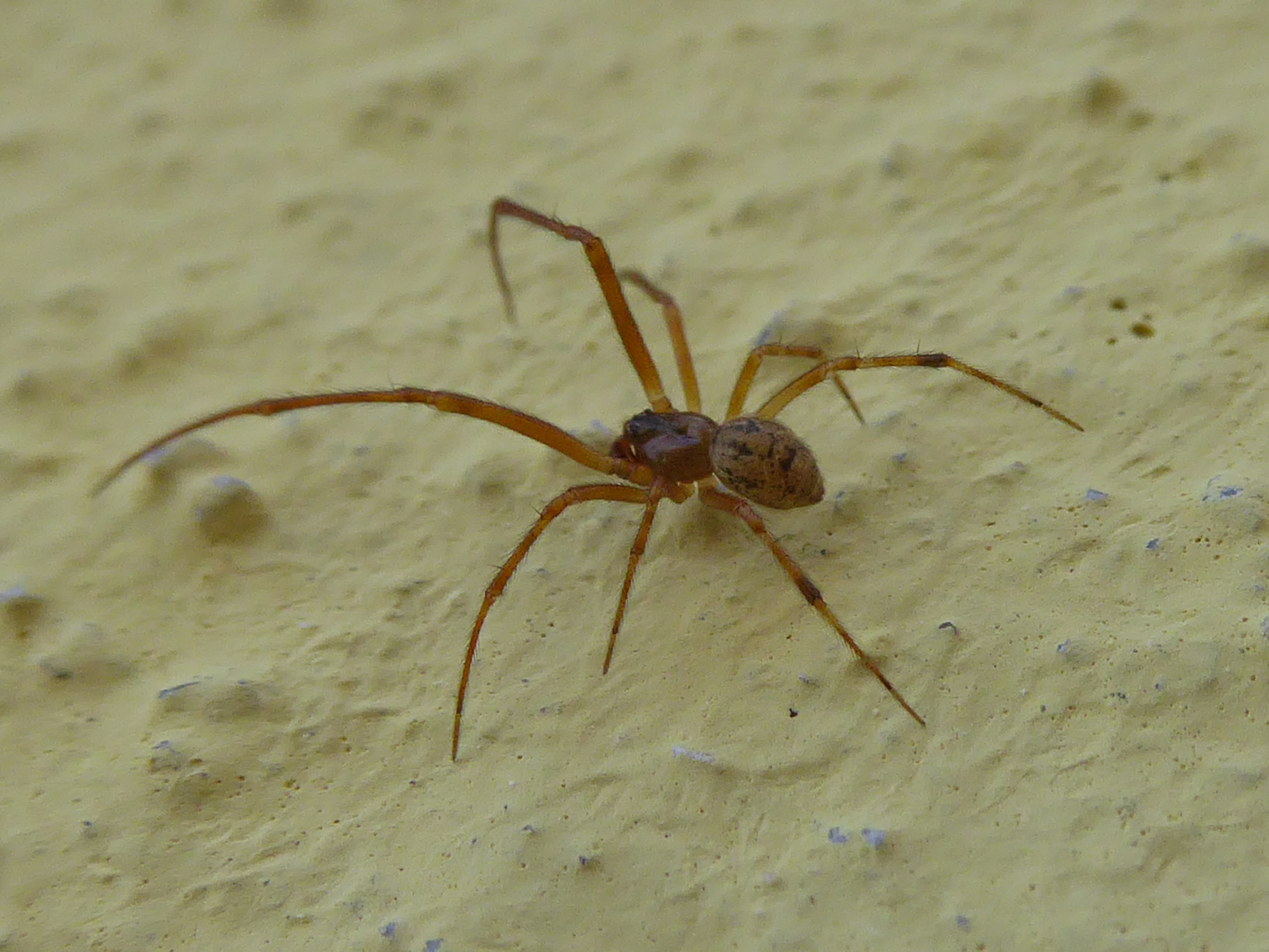There is a recurring cobweb just outside the front door. I knock it down, and it comes right back. We find them just below the ceiling on the deck, and even under the cupboards in the kitchen. The culprit is most likely an American (or common) house spider (Parasteatoda tepidariorum) or perhaps a pair of them.
As spiders go, these guys are tiny. She is only 5 to 6 millimeters long, and he’s even smaller at 3.8 to 4.7 millimeters. They’re both brown on their backs and dirty-white underneath with some gray accents. She has spindly yellow legs with darker rings around the joints, and his legs are orange. Both males and females have a row of stiff bristles or hairs on the lower part of the hindmost legs called foot combs. Like all spiders, house spiders have spinnerets on the underside of their bulbous abdomens which they use to produce silk.
House spiders build their webs in corners, underneath things, and in other places where they can attach the web to a stable surface. The type of web they weave is known as a tangle web because, unlike sheet webs or orb webs, the tangle web is just what it sounds like–a rather chaotic jumble of threads. We all know them as cobwebs.
To create this web, the spider begins by spinning out silk threads from one or more of her four spinnerets. She has silk glands which produce liquid silk. Each gland can produce a unique type of silk. Glands are attached to spinnerets, which are tiny nozzles with multiple openings. When she starts spinning her web, the spider activates one or more of these spinnerets. The liquid that is expressed through the spinnerets dries in contact with the air. She may produce several strands of one type of silk, or multiple strands of different types of silk depending on what she’s doing. The silk might be sticky or not, for instance, thick or thin. She uses the combs on the back of her legs to pull the silk out of the spinneret and deposit it where she wants it. In this way she attaches her web to supporting surfaces. She builds a thicker, stronger platform in the middle of the web where she can sit for hours at a time waiting for prey to stray into the web. As soon as a cockroach or fly steps on it and gets stuck, she begins throwing silk over it to trap it more securely. Once her prey is covered in silk, she will bite it, injecting neurotoxins that paralyze it and digestive juices that basically turn it into a protein shake.
The house spider uses her silk for other purposes, too. For instance, she can create a strand of silk that is so light and strong that when the wind comes along, it picks up the spider by the thread and moves her to another location. This is called ballooning, and explains how spiders, which don’t fly, get from one place to another.
Both male and female spiders build webs, although the female is better at it than her partner. When the male is ready to mate, he approaches the larger female, and a courtship dance ensues. If he succeeds, he may move into her web for the duration. After mating, the female deposits an egg sack on the web. The egg sack is brown and papery, somewhat pear-shaped, and contains from 150 to 400 eggs. The female spider guards the eggs for about a month until they hatch. The spiderlings hang around for a few days before dispersing to find their own corners to build their webs in. Spiders live up to a year, and a female can mate up to 12 times, depositing a dozen egg sacks accounting for from 18 to 48 hundred eggs in her lifetime.
Spider silk is considered the strongest fiber on earth. By weight it is three times tougher than Kevlar and five times stronger than steel. It’s even stronger than all manmade fibers. It’s also not soluble in water. It’s made of connected protein chains and areas of unconnected chains. This gives it both strength and flexibility.
Using spider silk as a fiber for clothing and other applications has been studied and attempted throughout history. They also have been used in medicine. In ancient Rome and Greece, spiderwebs were used to cover wounds and stop bleeding.
The dream of spider-silk cloth was realized in 2012 when a beautiful, shimmering golden cape and shawl made from orb spiderweb were exhibited at the Victoria and Albert museum in England. To make the cloth, fiber was harvested from over a million female orb spiders in Madagascar. The whole process of collecting, spinning and weaving the fiber was a huge undertaking. Spiders are not easy to farm. They are territorial and will fight and eat each other in a confined space. And it takes about 1500 strands of spider silk to make a single thread. Still, in the last ten years a lot of research has gone into creating synthetic spider silk or editing the genes of silkworms to produce it instead of traditional silk. Potential uses range from wound dressings, medical sutures and adhesives to parts for cars and airplanes.
The house spider that lives by my front door isn’t interested in all this speculation and experimentation, though. She just wishes I’d quit knocking down her web so she could eat in peace. I’m happy to have her guarding the door, catching insects before they come into the house. I’ll have to compromise with her.
Photo from Wikimedia.org by: Syrio Alt text: Tiny spider with long orange legs, indicating male. The rock-strewn desert surrounding him is the texturing of an interior house wall, which shows the size of this little guy. American house spider.

1 comment
Huh, I’ve never considered the etymology of the word “cobweb” before this! Thanks for finding these little treasures for us!